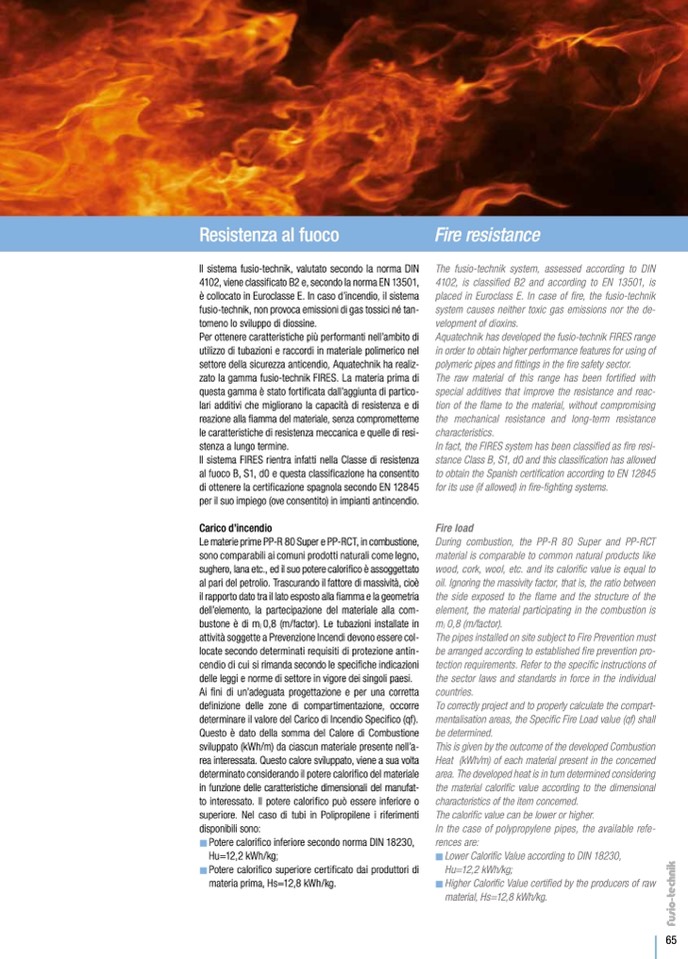
Resistenza al fuoco
Fire resistance
Il sistema fusio-technik, valutato secondo la norma DIN
4102, viene classificato B2 e, secondo la norma EN 13501,
è collocato in Euroclasse E. In caso d’incendio, il sistema
fusio-technik, non provoca emissioni di gas tossici né tan-
tomeno lo sviluppo di diossine.
Per ottenere caratteristiche più performanti nell’ambito di
utilizzo di tubazioni e raccordi in materiale polimerico nel
settore della sicurezza anticendio, Aquatechnik ha realiz-
zato la gamma fusio-technik FIRES. La materia prima di
questa gamma è stato fortificata dall’aggiunta di partico-
lari additivi che migliorano la capacità di resistenza e di
reazione alla fiamma del materiale, senza comprometterne
le caratteristiche di resistenza meccanica e quelle di resi-
stenza a lungo termine.
Il sistema FIRES rientra infatti nella Classe di resistenza
al fuoco B, S1, d0 e questa classificazione ha consentito
di ottenere la certificazione spagnola secondo EN 12845
per il suo impiego (ove consentito) in impianti antincendio.
Carico d’incendio
Le materie prime PP-R 80 Super e PP-RCT, in combustione,
sono comparabili ai comuni prodotti naturali come legno,
sughero, lana etc., ed il suo potere calorifico è assoggettato
al pari del petrolio. Trascurando il fattore di massività, cioè
il rapporto dato tra il lato esposto alla fiamma e la geometria
dell’elemento, la partecipazione del materiale alla com-
bustone è di m
i
0,8 (m/factor). Le tubazioni installate in
attività soggette a Prevenzione Incendi devono essere col-
locate secondo determinati requisiti di protezione antin-
cendio di cui si rimanda secondo le specifiche indicazioni
delle leggi e norme di settore in vigore dei singoli paesi.
Ai fini di un’adeguata progettazione e per una corretta
definizione delle zone di compartimentazione, occorre
determinare il valore del Carico di Incendio Specifico (qf).
Questo è dato della somma del Calore di Combustione
sviluppato (kWh/m) da ciascun materiale presente nell’a-
rea interessata. Questo calore sviluppato, viene a sua volta
determinato considerando il potere calorifico del materiale
in funzione delle caratteristiche dimensionali del manufat-
to interessato. Il potere calorifico può essere inferiore o
superiore. Nel caso di tubi in Polipropilene i riferimenti
disponibili sono:
Potere calorifico inferiore secondo norma DIN 18230,
Hu=12,2 kWh/kg;
Potere calorifico superiore certificato dai produttori di
materia prima, Hs=12,8 kWh/kg.
The fusio-technik system, assessed according to DIN
4102, is classified B2 and according to EN 13501, is
placed in Euroclass E. In case of fire, the fusio-technik
system causes neither toxic gas emissions nor the de-
velopment of dioxins.
Aquatechnik has developed the fusio-technik FIRES range
in order to obtain higher performance features for using of
polymeric pipes and fittings in the fire safety sector.
The raw material of this range has been fortified with
special additives that improve the resistance and reac-
tion of the flame to the material, without compromising
the mechanical resistance and long-term resistance
characteristics.
In fact, the FIRES system has been classified as fire resi-
stance Class B, S1, d0 and this classification has allowed
to obtain the Spanish certification according to EN 12845
for its use (if allowed) in fire-fighting systems.
Fire load
During combustion, the PP-R 80 Super and PP-RCT
material is comparable to common natural products like
wood, cork, wool, etc. and its calorific value is equal to
oil. Ignoring the massivity factor, that is, the ratio between
the side exposed to the flame and the structure of the
element, the material participating in the combustion is
m
i
0,8 (m/factor).
The pipes installed on site subject to Fire Prevention must
be arranged according to established fire prevention pro-
tection requirements. Refer to the specific instructions of
the sector laws and standards in force in the individual
countries.
To correctly project and to properly calculate the compart-
mentalisation areas, the Specific Fire Load value (qf) shall
be determined.
This is given by the outcome of the developed Combustion
Heat (kWh/m) of each material present in the concerned
area. The developed heat is in turn determined considering
the material calorific value according to the dimensional
characteristics of the item concerned.
The calorific value can be lower or higher.
In the case of polypropylene pipes, the available refe-
rences are:
Lower Calorific Value according to DIN 18230,
Hu=12,2 kWh/kg;
Higher Calorific Value certified by the producers of raw
material, Hs=12,8 kWh/kg.
65

